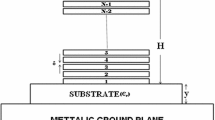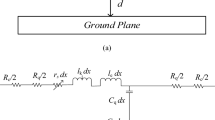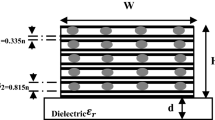Abstract
In the present research, the Fermi energy and temperature-dependent performance of a multilayer graphene nanoribbon (MLGNR) in terms of signal delay and power delay product (PDP) at the global interconnect length for three different technology nodes (32 nm, 22 nm, and 16 nm) were investigated in detail. A Fermi energy and temperature-dependent equivalent single conductor (ESC) based on the analytical model of MLGNR was proposed to evaluate the parasitic parameters, which capture the variations in Fermi energy and electron–phonon scattering as a function of temperature. It was found that the intercalation doping significantly raised the Fermi energy of each layer of MLGNR and consequently, increased its overall conductivity for all three technology nodes. The simulation program with integrated circuit emphasis (SPICE) tool was employed to simulate the parasitic parameters of MLGNR, and results revealed that signal delay and PDP of MLGNR increased with the increasing temperatures (200–500 K); however, gradually decreased with the rise in Fermi energy at 2000 μm length for all three technology nodes. Further, the performances of MLGNR, single-walled carbon nanotube (SWCNT), and copper interconnects were compared in the SPICE simulator, and it was noticed that the intercalation doping of MLGNR yielded a much better performance (as compared to SWCNT and copper interconnects) in terms of signal delay and PDP for all three technology nodes.











Similar content being viewed by others
References
Dennard, R. H., Gaensslen, F. H., Rideout, V. L., Bassous, E., & LeBlanc, A. R. (1974). Design of ion-implanted MOSFET's with very small physical dimensions. IEEE Journal of Solid-State Circuits,9(5), 256–268.
Sze, S. M., & Ng, K. K. (2006). Physics of semiconductor devices. New Jersy: Wiley.
Rossnagel, S. M., & Kuan, T. S. (2004). Alteration of Cu conductivity in the size effect regime. Journal of Vacuum Science and Technology B: Microelectronics and Nanometer Structures Processing, Measurement, and Phenomena,22(1), 240–247.
Steinhögl, W., Schindler, G., Steinlesberger, G., Traving, M., & Engelhardt, M. (2005). Comprehensive study of the resistivity of copper wires with lateral dimensions of 100 nm and smaller. Journal of Applied Physics,97(2), 023706-1–023706-7.
Ogawa, E. T., Lee, K. D., Blaschke, V. A., & Ho, P. S. (2002). Electromigration reliability issues in dual-damascene Cu interconnections. IEEE Transactions on Reliability,51(4), 403–419.
Sharma, H., & Sandha, K. S. (2019). Impact of Intercalation Doping on the Conductivity of Multi-layer Graphene Nanoribbon (MLGNR) in On-Chip Interconnects. Journal of Circuits, Systems and Computers.. https://doi.org/10.1142/S0218126620501856.
Srivastava, N., & Banerjee, K. (2004). Interconnect challenges for nanoscale electronic circuits. JOM Journal of the Minerals Metals and Materials Society,56(10), 30–31.
Xu, C., Li, H., & Banerjee, K. (2009). Modeling, analysis, and design of graphene nano-ribbon interconnects. IEEE Transactions on Electron Devices,56(8), 1567–1578.
Kim, R. H., Bae, M. H., Kim, D. G., Cheng, H., Kim, B. H., Kim, D. H., et al. (2011). Stretchable, transparent graphene interconnects for arrays of microscale inorganic light emitting diodes on rubber substrates. Nano Letters,11(9), 3881–3886.
Politou, M., Asselberghs, I., Soree, B., Lee, C. S., Sayan, S., Lin, D., et al. (2016). Single-and multilayer graphene wires as alternative interconnects. Microelectronic Engineering,156, 131–135.
Agapito, L. A., & Kioussis, N. (2011). “Seamless” graphene interconnects for the prospect of all-carbon spin-polarized field-effect transistors. The Journal of Physical Chemistry C,115(6), 2874–2879.
Chin, H. C., Lim, C. S., Wong, W. S., Danapalasingam, K. A., Arora, V. K., & Tan, M. L. P. (2014). Enhanced device and circuit-level performance benchmarking of graphene nanoribbon field-effect transistor against a nano-MOSFET with interconnects. Journal of Nanomaterials,2014, 1–14.
Wakabayashi, K., Fujita, M., Ajiki, H., & Sigrist, M. (1999). Electronic and magnetic properties of nanographite ribbons. Physical Review B,59(12), 8271–8282.
Naeemi, A., & Meindl, J. D. (2008). Electron transport modeling for junctions of zigzag and armchair graphene nanoribbons (GNRs). IEEE Electron Device Letters,29(5), 497–499.
Zhao, W. S., & Yin, W. Y. (2014). Comparative study on multilayer graphene nanoribbon (MLGNR) interconnects. IEEE Transactions on Electromagnetic Compatibility,56(3), 638–645.
Hazra, A., & Basu, S. (2018). Graphene nanoribbon as potential on-chip interconnect material—A review. C-Journal of Carbon Research,4(3), 49–75.
Singh, K., & Raj, B. (2015). Temperature-dependent modeling and performance evaluation of multi-walled CNT and single-walled CNT as global interconnects. Journal of Electronic Materials,44(12), 4825–4835.
Singh, K., & Raj, B. (2015). Influence of temperature on MWCNT bundle, SWCNT bundle and copper interconnects for nanoscaled technology nodes. Journal of Materials Science: Materials in Electronics,26(8), 6134–6142.
Singh, K., & Raj, B. (2015). Performance and analysis of temperature dependent multi-walled carbon nanotubes as global interconnects at different technology nodes. Journal of Computational Electronics,14(2), 469–476.
Hone, J., Whitney, M., Piskoti, C., & Zettl, A. (1999). Thermal conductivity of single-walled carbon nanotubes. Physical Review B,59(4), 1954231–19542320.
Rai, M. K., Arora, S., & Kaushik, B. K. (2018). Temperature-dependent modeling and performance analysis of coupled MLGNR interconnects. International Journal of Circuit Theory and Applications,46(2), 299–312.
Sharma, H., & Sandha, K. S. (2019). Thermally Aware Modeling and Performance Analysis of MLGNR as On-Chip VLSI Interconnect Material. Journal of Electronic Materials,48(8), 4902–4912.
Naeemi, A., & Meindl, J. D. (2009). Compact physics-based circuit models for graphene nanoribbon interconnects. IEEE Transactions on Electron Devices,56(9), 1822–1833.
Perebeinos, V., & Avouris, P. (2010). Inelastic scattering and current saturation in graphene. Physical Review B,81(19), 195442-1–195442-8.
Hosseini, A., & Shabro, V. (2010). Thermally-aware modeling and performance evaluation for single-walled carbon nanotube-based interconnects for future high performance integrated circuits. Microelectronic Engineering,87(10), 1955–1962.
Pop, E., Mann, D. A., Goodson, K. E., & Dai, H. (2007). Electrical and thermal transport in metallic single-wall carbon nanotubes on insulating substrates. Journal of Applied Physics,101(9), 093710-1–093710-10.
Predictive Technology Model (PTM), https://ptm.asu.edu. Accessed 15 April 2019.
International Technology Roadmap for Semiconductors (ITRS-2013), https://www.itrs2.net/itrs-reports.html. Accessed 15 April 2019.
Author information
Authors and Affiliations
Corresponding author
Additional information
Publisher's Note
Springer Nature remains neutral with regard to jurisdictional claims in published maps and institutional affiliations.
Rights and permissions
About this article
Cite this article
Sharma, H., Sandha, K.S. Investigation on the combined effects of variable Fermi energies and temperatures on the performance of multilayer graphene nanoribbon as interconnects. Analog Integr Circ Sig Process 104, 157–168 (2020). https://doi.org/10.1007/s10470-020-01681-2
Received:
Revised:
Accepted:
Published:
Issue Date:
DOI: https://doi.org/10.1007/s10470-020-01681-2




